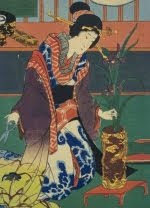This summer I've read a very fascinating biography of the Tibetan Buddhist teacher Chögyam Trungpa Rinpoche. Trungpa, who died in Canada in 1987, was born in Tibet. From a young age he received training to become a Lama. He was forced to flee to India in 1959 to escape the Chinese invation. He also lived a few years in England, studying religion, philosophy, and fine arts at Oxford, before leaving for the US where he introduced Tibetan Buddhism to Westerners and founded the Shambhala organization.
Through his teachings he aimed to bring meditation into daily life. Trungpa was also an artist, and inspired by the Japanese Zen Buddhism he introduced his students to diciplines like calligraphy, archery and ikebana. Bringing art to everyday life is a way of integrating meditation practice in your life. There can be a quality of meditation and art in all the things you do during a day. In this sence it doesn't matter if you're washing dishes or making a flower arrangement. Art is not separate from daily life, although artistic work represents a heightening of experience. Trungpa called this "extending the mind through the sense perceptions".
When he lived in England, Trungpa studied Ikebana with Stella Coe, a well reputed teacher of the Sogetsu School. Trungpa says he was shocked and surprised that such a new dimension of working with reality could be expressed through arranging. He studied with Coe until he received a teachers degree from the Sogetsu School.

Trungpa loved working together with a group, and he loved making large arrangements, the main branch being "as large as a tree". One of his favorite flowers to arrange were white chrysanthemum, as seen in this picture.
In 1982 Trungpa founded the Kalapa Ikebana School. It teaches Kado, the way of flowers, as a meditation practice. In Trungpa's opinion the actual result was not as important as the experience of arranging. Through the arts man can be involved in joining heaven and earth, heaven being the visionary principle that can be grounded and accommodated by earth.

The book that I've read is "Chögyam Trungpa: His Life and Vision" by the French writer Fabrice Midal, Shambhala, Boston & London 2004.
Through this link you'll find information on Kado programs held at the Shambhala centers. I'm planning to take part in a weekend program in Rotterdam in October. If you have experiences with these programs you're very welcome to comment.













